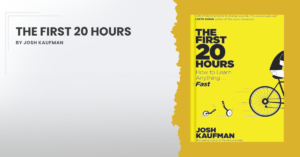Title: Storynomics: Story-Driven Marketing in the Post-Advertising World
Author: Robert McKee, Thomas Gerace
Year: 2018
Pages: 256
Robert McKee is well-known for his writing workshops. Many of his students have won major awards like Oscars and Emmys.
In Storynomics, McKee partners with digital marketing expert Tom Gerace. Together, they help brands figure out how to stand out in today’s world of constant ads.
They’ve already helped big companies like Samsung and Nike change how they advertise. Now, in Storynomics, they’re sharing their advice with business leaders and entrepreneurs.
They believe that telling stories is the best way to get your message across in the digital age.
As a result, I gave this book a rating of 7.5/10.
For me, a book with a note 10 is one I consider reading again. Among the books I rank with 10, for example, is Dale Carnegie’s How to Win Friends and Influence People.
3 Reasons to Read Storynomics
Unlock Emotional Engagement
Storynomics shows the power of narrative to captivate audiences emotionally. By weaving compelling stories, businesses can forge genuine connections with their customers, fostering loyalty and trust.
In an era inundated with information, businesses struggle to capture attention. Storynomics equips readers with the tools to use storytelling as a potent vehicle for communication and persuasion.
Foster Organizational Alignment
By equipping company narratives with authenticity and purpose, leaders can inspire employees and align collective efforts towards shared goals.
Book Overview
Storynomics by Robert McKee and Thomas Gerace is a book about the power of storytelling in business. It explains how stories can be used to connect with customers, inspire action, and drive success.
The authors argue that in today’s world, where people are bombarded with information, stories are essential for cutting through the noise and making a lasting impact.
According to the first chapter of “Storynomics” by Robert McKee, the story of how advertising started in the United States began innocently enough in the 1700s. At that time, weekly newspapers detailing local life and politics in the American colonies were sprouting up everywhere, but then quickly shriveling and dying for two key reasons.
First, printing required a license from the Crown that specifically prohibited any satire or criticism of the king’s representatives. A simple cartoon ridiculing the royal governor could land the cartoonist a ticket to the whipping post.
Second, these early newspapers resisted the tactic of placing ads directly in the readers’ way as they read the stories. However, addicted as they were to the ad income, the publishers soon made this practice a newspaper norm, forcing readers to jump through the ads to finish a story. This instinct to interrupt the reader’s flow would prove to be an enduring challenge for the advertising industry.
Storynomics begins by exploring the fundamental elements of storytelling, such as character, plot, and conflict.
It then delves into how these elements can be applied to business, showing how companies can use storytelling to create compelling marketing campaigns, engage employees, and build a strong brand identity.
One of the key insights of Storynomics is that stories are more than just entertainment – they are a powerful tool for persuasion.
Storynomics Chapter 1 – Advertising, A Story of Addiction: This chapter traces the rise and fall of advertising, from its origins in the 1700s American colonies to its current crisis. Advertising initially grew as a way for newspapers to generate revenue, but faced challenges due to restrictions on criticizing the Crown. Over time, advertising became the dominant business model for media, fueling the growth of newspapers, radio, and television. However, the chapter argues that this model is now collapsing, as consumers increasingly avoid ads through ad blockers and subscription services. Marketers are losing faith in advertising’s ability to deliver customers, leading them to seek alternative approaches.
Storynomics Chapter 2 – Marketing, A Story of Deception: This chapter argues that the problem with marketing goes deeper than just the advertising model. It traces the roots of marketing logic back to its origins, suggesting that marketing has always been based on deception – making promises that are not kept, and trying to manipulate consumers rather than truly serving their needs. The chapter suggests that this deceptive approach is no longer viable in the modern, more transparent world, and that marketers must fundamentally rethink their approach.
Storynomics Chapter 3 – The Evolution of Story: This chapter explores the evolutionary origins of storytelling, tracing how the human mind developed the capacity for narrative thinking. It argues that story is a fundamental mode of human cognition, allowing us to make sense of the world and guide our actions. The chapter suggests that this innate human tendency towards storytelling is what makes it such a powerful tool for marketing and communication.
Storynomics Chapter 4 – The Definition of Story: This chapter provides a precise definition of what constitutes a story, outlining its eight key elements: the target audience, the subject matter, the inciting incident, the object of desire, the first action, the progressive complications, the crisis, and the climax and resolution. It argues that mastering these elements is essential for crafting effective, purpose-driven stories for marketing.
Storynomics Chapter 5 – The Full Story: Building on the previous chapter, this chapter delves deeper into the contents and dynamics of each of the eight story elements. It explains how these elements work together to create meaning, express causality, and guide the audience’s decisions and actions. The chapter emphasizes the importance of understanding the full structure of story in order to wield it effectively in a marketing context.
Storynomics Chapter 6 – The Purpose-Told Story: This chapter outlines the process of creating a “purpose-told story” – a story designed specifically to drive a desired consumer action or outcome. It explains how the eight stages of story structure can be adapted to align with marketing objectives, targeting a specific audience, need, and end result. The chapter highlights the importance of defining these three targets as the foundation for an effective purpose-told story.
Storynomics Chapter 7 – Story and the CMO: This chapter positions the Chief Marketing Officer (CMO) as the master storyteller, responsible for envisioning the overarching narrative and guiding the creative team in transforming it into action. It emphasizes the CMO’s role in aligning the organization’s various marketing, branding, advertising, and sales efforts around a cohesive, story-driven strategy.
Storynomics Chapter 8 – Storified Branding: This chapter explores how brands can use storytelling to overcome consumer skepticism and build genuine affinity. It explains how a brand’s story can convey its values, personality, and unique positioning in a way that resonates emotionally with the target audience. The chapter provides examples of brands that have successfully leveraged storytelling to strengthen their brand identity.
Storynomics Chapter 9 – Storified Advertising: This chapter argues that the most effective advertising is story-driven, using narrative techniques to hook the audience, hold their attention, and deliver a meaningful message. It outlines strategies for crafting ads that function as mini-stories, guiding the consumer through a compelling experience that aligns with the brand’s purpose.
Storynomics Chapter 10 – Storified Demand and Lead Generation: This chapter examines how marketers can use storytelling to drive demand and generate high-quality leads. It explains how a story-centric approach to content marketing, email nurturing, and other lead gen tactics can create a more engaging, personalized experience that moves prospects through the sales funnel.
Storynomics Chapter 11 – Building Audience: This chapter focuses on how brands can leverage storytelling to build and expand their audience across digital channels. It explores strategies for integrating brand stories into the broader content ecosystem, earning attention and loyalty through compelling narratives that resonate with target consumers.
Storynomics Chapter 12 – Storified Sales: This chapter delves into the role of storytelling in the sales process, from face-to-face interactions to the viral spread of word-of-mouth. It outlines techniques for sales teams to use narrative to build trust, demonstrate value, and guide customers towards a purchase decision.
Storynomics Chapter 13 – Nomics: The final chapter examines how marketers can measure the business impact of their storytelling efforts, comparing the efficacy of story-driven approaches to traditional advertising. It introduces the concept of “Storynomics” – the data-driven analysis of story’s fiscal value – and forecasts the continued growth of story-centric marketing in the face of technological change.
By framing information within a narrative structure, businesses can make their message more memorable and persuasive following the right story design according to the storynomics method:

Stage 1: Define Your Target Audience
The first step is to clearly identify your target audience. This involves researching their demographics, needs, and desires. Understand who you’re trying to reach and what emotional response you want to evoke.
Stage 2: Establish the Subject Matter
Next, you’ll need to build the foundation of your story by defining the physical and social setting, the protagonist, and the core value or conflict. The more specific and unique these elements are, the more universal the story’s appeal will be.
Stage 3: The Inciting Incident
The inciting incident is the event that suddenly throws the protagonist’s life out of balance and sets the story in motion. This surprising occurrence grabs the audience’s curiosity and pulls them through the narrative.
Stage 4: The Object of Desire
The protagonist’s core desire, whether it’s a tangible object or an abstract goal, is what drives the story forward. This desire must be closely tied to the story’s central value or conflict.
Stage 5: The First Action
In this stage, the protagonist takes an action based on their best expectations, kicking off their quest to fulfill their desire. This initial step sets the stage for the rising action to come.
Stage 6: Progressive Complications
As the story progresses, the protagonist faces a series of obstacles and challenges that increase the tension and raise the stakes. These complications push the character to make difficult choices and grow.
Stage 7: The Crisis
The crisis is the moment of greatest jeopardy, where the protagonist must make a critical decision that will determine the outcome of the story. This is the climactic point that the audience has been building towards.
Stage 8: The Climax and Resolution
The climax is the story’s turning point, where the protagonist’s actions lead to a decisive outcome. The resolution then follows, providing a satisfying conclusion that leaves the audience with a meaningful emotional experience.
The authors of Storynomics provide numerous examples of companies that have successfully used storytelling to achieve their goals, from small startups to multinational corporations.
Throughout the book, McKee and Gerace emphasize the importance of authenticity in storytelling. They argue that in order for stories to be effective, they must be genuine and resonate with the audience on a personal level.
This means being honest about both the successes and failures of the company, and showing vulnerability where appropriate.
What are the Key Ideas
The Power of Narrative Structure
McKee and Gerace elucidate the fundamental components of storytelling, emphasizing the importance of character development, plot progression, and thematic resonance. Adhering to a coherent narrative structure, businesses can craft compelling brand stories that resonate with their target audience.
Authenticity and Vulnerability
Central to the efficacy of storytelling is authenticity. Storynomics advocates for transparency and vulnerability in narratives, encouraging businesses to embrace both their triumphs and tribulations. Authenticity fosters trust and cultivates genuine connections with customers.
Strategic Application of Storytelling
Beyond mere storytelling, Storynomics explores the strategic application of narratives across various domains of business. From marketing campaigns to internal communications, stories serve as a versatile tool for engagement, persuasion, and organizational alignment.
Emotional Resonance and Brand Loyalty
Successful storytelling elicits emotional responses from audiences, forging lasting impressions and cultivating brand loyalty. Tapping into universal human experiences and emotions, businesses can create narratives that resonate deeply with their customers, fostering long-term relationships.
What are the Main Lessons
Craft Compelling Brand Stories
Storynomics shows that by aligning narratives with audience aspirations and emotions, brands can forge enduring connections and foster brand loyalty.
Embrace Authenticity
Businesses should embrace vulnerability and transparency in their narratives, showcasing their journey, challenges, and triumphs.
Emotional Engagement
Businesses should strive to evoke emotions such as empathy, joy, or inspiration through their narratives, fostering deeper connections with their audience.
Storytelling Across Channels
By integrating storytelling across channels, businesses can ensure consistency and coherence in their messaging, amplifying the impact of their narratives.
Iterate and Adapt
Effective storytelling is an iterative process. Businesses should continuously refine and adapt their narratives based on audience feedback and market insights.
Measure Impact and Iterate
By measuring the impact of their narratives, brands can identify areas for improvement and refine their storytelling strategies for maximum efficacy.
My Book Highlights & Quotes
This was the true genius of Steve Jobs. He saw what no one else saw: Computers were ugly. He called Dell’s products “uninnovative beige boxes. And he was right. It hurt just to look at Dell’s wire-sprouting, cumbersome plastic cartons, let alone pick one up and carry it around. Jobs sensed what consumers subconsciously wanted but didn’t consciously realize: a unique identity. To see themselves as rebellious, creative, and elite. So he made machines that symbolized those qualities with beauty, touch, and grace as they move from room to room, desk to pocket. Jobs’s dream of mobile phones spoke to the unspoken needs of the consumer. Apple storified his vision in a series of brilliant commercials, and the rest is branding history.
The mental mirror experience begins and ends with curiosity. A story’s inciting incident teases the audience’s mind with unanswered questions such as “What’s going to happen next? What’ll happen after that? How will this story turn out? Will the protagonist win his object of desire?” The rational mirror experience in story mirrors the same set of concerns and questions we ask of our everyday life. As Shakespeare said, a story holds a mirror up to nature.
The core value that pulses at the heart of a story determines its specific meaning and unique emotional impact.
Overall, Storynomics offers valuable insights into the art and science of storytelling in business.
It provides practical advice for businesses looking to harness the power of storytelling to connect with customers, drive sales, and achieve their goals.
Whether you’re a marketer, entrepreneur, or business leader, this book is sure to inspire you to think differently about how you communicate with your audience.
I am incredibly grateful that you have taken the time to read this post.
Do you want to get new content in your Email?
Do you want to explore more?
Check my main categories of content below:
- Agile
- Blog
- Book Notes
- Career
- Leadership
- Management
- Managing Yourself
- Productivity
- Project Management
- Technology
- Weekly Pulse
Navigate between the many topics covered in this website:
Agile Art Artificial Intelligence Blockchain Books Business Business Tales Career Coaching Communication Creativity Culture Cybersecurity Design DevOps Economy Emotional Intelligence Feedback Flow Focus Gaming Goals GPT Habits Health History Innovation Kanban Leadership Lean Life Managament Management Mentorship Metaverse Metrics Mindset Minimalism Motivation Negotiation Networking Neuroscience NFT Ownership Parenting Planning PMBOK PMI Politics Productivity Products Project Management Projects Pulse Readings Routines Scrum Self-Improvement Self-Management Sleep Startups Strategy Team Building Technology Time Management Volunteering Work
Do you want to check previous Book Notes? Check these from the last couple of weeks:
- Book Notes #123: The Personal MBA by Josh Kaufman
- Book Notes #122: The First 20 Hours by Josh Kaufman
- Book Notes #121: A World Without Email by Cal Newport
- Book Notes #120: Storynomics by Robert McKee and Thomas Gerace
- Book Notes #119: Getting Things Done by David Allen
Support my work by sharing my content with your network using the sharing buttons below.
Want to show your support tangibly? A virtual coffee is a small but nice way to show your appreciation and give me the extra energy to keep crafting valuable content! Pay me a coffee:





